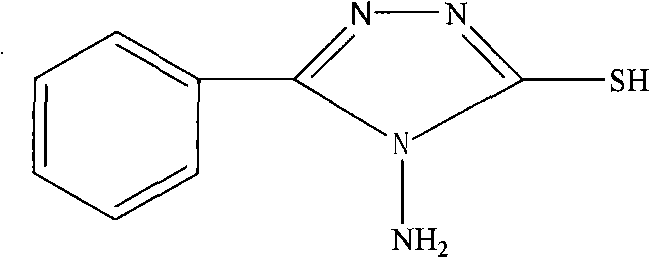Application of triazole compounds in corrosion inhibitor for copper in seawater
A technology of triazoles and compounds is applied in the field of nitrogen-containing heterocyclic corrosion inhibitors, which can solve the problems of scarcity, poor activity and loss of performance of corrosion inhibitors, and achieve the effects of convenient purchase, low cost, and damage inhibition.
- Summary
- Abstract
- Description
- Claims
- Application Information
AI Technical Summary
Problems solved by technology
Method used
Image
Examples
Embodiment 1
[0019] Metal corrosion is an electrochemical process. Whether the corrosion is serious and whether the protection is adequate can be judged from the corrosion current and charge transfer resistance. The main methods of measuring electrochemical corrosion are electrochemical impedance spectroscopy and polarization curve method. Through AC impedance spectroscopy, the charge transfer resistance of copper can be obtained. The larger the charge transfer resistance, the denser the protective film of the corrosion inhibitor molecules on the copper surface, and the better the protection of copper. The reduction can be obtained by formula (1). Corrosion inhibitor efficiency of copper. On the other hand, by the polarization curve method, the corrosion current of copper can be obtained. The larger the corrosion current, the more serious the corrosion. Therefore, the corrosion current is used to obtain the corrosion inhibition efficiency of the corrosion inhibitor according to formula (2) t...
Embodiment 2
[0026] Experimental conditions: The experimental material is red copper (mass concentration 99.999%), triazole compounds are used as copper seawater corrosion inhibitors, and the copper seawater corrosion inhibitors are directly added to the medium, and the copper products are immersed in it. The immersion temperature is 25℃ , PH range is 7.5, immersion for 1 hour; triazole compound copper seawater corrosion inhibitor is: 4-amino-5-phenyl-4H-1,2,4-triazole-3-thiol is dissolved In cyclohexanone, and emulsifier OP-10 to make a microemulsion, the medium is 3.5% sodium chloride solution, the amount is 0.5L, the corrosion inhibitor is 4-amino-5-phenyl-4H-1,2, The effective content of 4-triazole-3-thiol is 0.01g.
[0027] The corrosion inhibition efficiencies obtained through experimental tests are: electrochemical impedance spectroscopy 78.1%, and potentiodynamic polarization 80.9%, showing that it is a corrosion inhibitor with low dosage and high efficiency.
Embodiment 3
[0029] Experimental conditions: The experimental material is red copper (mass concentration 99.999%), triazole compounds are used as copper seawater corrosion inhibitors, and the copper seawater corrosion inhibitors are directly added to the medium, and the copper products are immersed in it. The immersion temperature is 25℃ , PH range is 7.5, immersion for 1 hour; triazole compound copper seawater corrosion inhibitor is: 4-amino-5-phenyl-4H-1,2,4-triazole-3-thiol is dissolved In cyclohexanone, and emulsifier OP-10 to make a microemulsion, the medium is 3.5% sodium chloride solution, the amount is 0.5L, the corrosion inhibitor is 4-amino-5-phenyl-4H-1,2, The effective content of 4-triazole-3-thiol is 0.015g.
[0030] The corrosion inhibition efficiencies obtained through experimental tests are: electrochemical impedance spectroscopy 82.9%, and potentiodynamic polarization 81.6%, showing that it is a corrosion inhibitor with low dosage and high efficiency.
PUM
 Login to View More
Login to View More Abstract
Description
Claims
Application Information
 Login to View More
Login to View More - R&D
- Intellectual Property
- Life Sciences
- Materials
- Tech Scout
- Unparalleled Data Quality
- Higher Quality Content
- 60% Fewer Hallucinations
Browse by: Latest US Patents, China's latest patents, Technical Efficacy Thesaurus, Application Domain, Technology Topic, Popular Technical Reports.
© 2025 PatSnap. All rights reserved.Legal|Privacy policy|Modern Slavery Act Transparency Statement|Sitemap|About US| Contact US: help@patsnap.com

